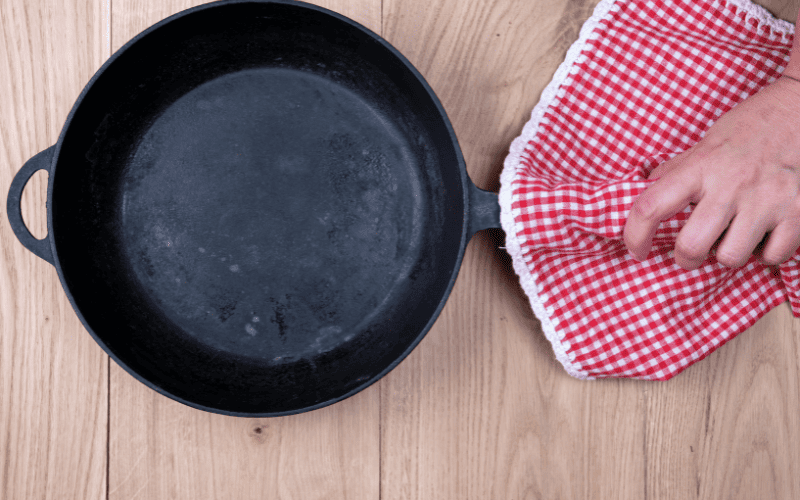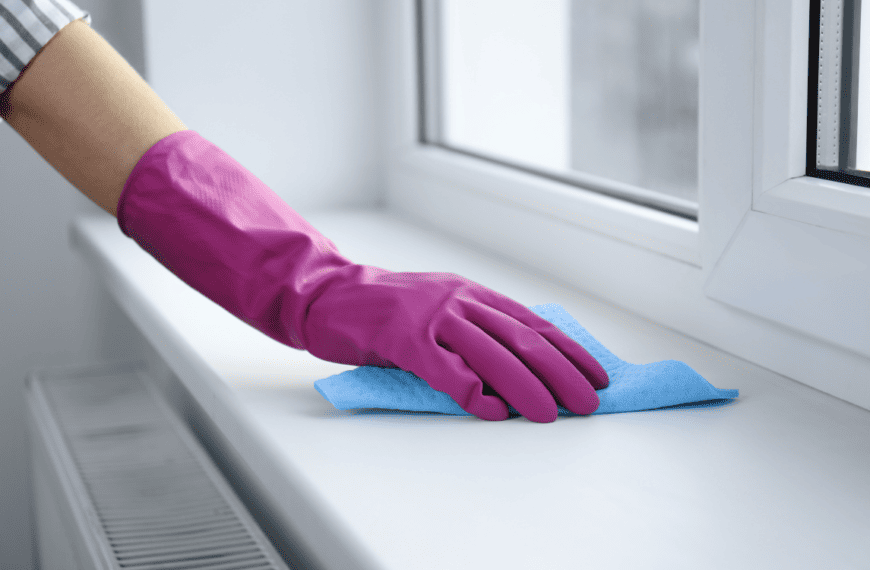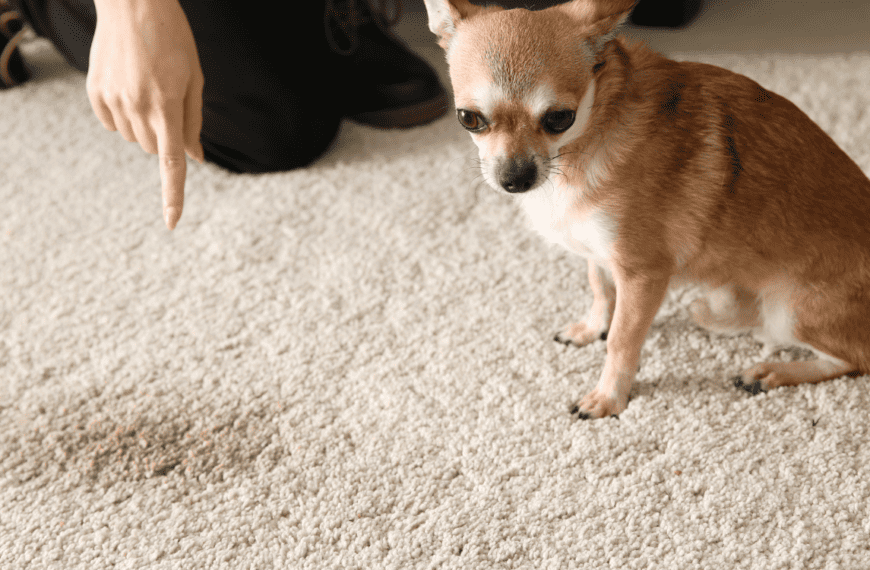It took me a while to get on the cast iron skillet train. The fear of not knowing how to clean black residue off the cast iron skillet properly was real. Then, a meal covered in black residue (imagine fried eggs looking like it’s got soot on it. Yes!) nearly made me give up on cast iron cookware. I eventually figured out and learned how to tackle this issue. The process is straightforward, and the black residue, while not pretty, isn’t harmful. Let’s delve into keeping your skillet in top shape!
How To Clean Black Residue Off Cast Iron Skillet
To clean the black residue off a cast iron skillet, you should first heat the pan with a little water. I do this right on my stovetop, although you can do it in the oven. Once the pan is hot, I carefully remove the water and dry the pan as best I can (be careful not to burn your hand). Next, pour half a cup of salt into the bottom of the pan and use a kitchen brush to scrub off all the black residue. The salt will turn a brownish color, which is fine. Remove all the salt and leftover debris from the pan and then go through the seasoning process.
You may also like:
The Complete Cast Iron Care Guide
Can You Put Cast Iron in the Dishwasher?
What is The Best Oil to Season a Cast Iron Skillet: 8 Options
How to Store a Cast Iron Skillet: 8 Best Tips
Alternative Methods For Cleaning Cast Iron Black Residue
Salt is my favorite trick to get black residue off of cast iron pans. However, there are a few ways to remove this black coating. I promise once you get comfortable with the process of caring for cast iron cookware, it’s well worth it. I’ve found so many one-pot cast iron meals to make for my family.
Cast Iron Scraper
A cast iron scraper (or pan scraper) is a small piece of polycarbonate that makes it easier to remove both black residue on cast iron and any stuck-on food that your cast iron skillet may have in place. These handy kitchen tools are cheap and can be used on more than just your cast iron pans.
- Immediately after using your cast iron skillet, wipe out all food and excess debris
- Use the scraper in your hand to push up any black residue or food that is stuck in the pan
- If the food is really stuck, you can heat the pan and then let it cool and try again. I find the scrapers to work best when the cast iron skillet is dry, so the scraper can get under the flaky black residue
- When finished, check to see if your cast iron skillet needs to be reseasoned; chances are it will
Baking Soda
If you have been reading my kitchen and laundry cleaning guides, you know how much I use baking soda around the house. When my cast iron pan first showed signs of leaving black residue, my first thought was baking soda. Guess what? I wasn’t wrong!
- Place about half cup of baking soda into the bottom of your cast iron skillet
- Use a kitchen brush to scrub the baking soda into the skillet; you will need a little elbow grease.
- I then like to pour some water into the pan and continue scrubbing.
- Baking soda has a natural abrasive property, so for mild issues with black residue, it’s the perfect solution; for more advanced issues, add a little salt to the pan with the baking soda.
- Clean out all baking soda and black residue and then reseason the cast iron cookware.
Soap and Scrub
Yes, you can use soap in your cast iron skillet, but it’s not my favorite method because it tends to strip my cast iron of its seasoning. So, keep the soap to a minimum and instead rely on a scrub brush that is made specifically for cast iron.
- Heat water in your cast iron skillet for about 15 to 20 minutes to loosen up any debris
- Pour out the water and then create a solution of half a cup of water and a teaspoon of Dawn dish soap
- Take a cast iron scrub brush, dip it in the solution, and use it to scrape away the black residue.
- After using the soap, you will have to rinse the skillet, dry it and then re season it. It’s best to avoid soap as it will require you to reseason a skillet, but soap can help to break down the black residue.
Salt
Salt is the best method and the one that has always worked well for me.
- Add half a cup of salt to the base of your dry cast iron skillet.
- Use a scrub brush or even a cleaning cloth to scrub the cast iron cookware; the grit and texture of the salt break up the black residue.
- Continue until the salt starts to turn color and absorb more of the black residue.
- Rinse the skillet, remove all loose pieces, and then re-season the pan.
Stiff Brush
A stiff brush with a firm handle can be used to remove black residue from cast iron skillets. I mentioned above that you could use a water and soap solution with the brush, but I actually prefer to do this process with a dry skillet. Using a stiff brush on a dry skillet can easily scrub away the black residue without the risk of damaging the seasoning.
Proper Care and How To Prevent Black Residue
When I first got my cast iron skillet, I was much more concerned with recipes I could make than with cleaning. In hindsight, that was a mistake. Here are the steps I follow now to reduce black residue and keep my cast iron skillet in great shape.
Make sure to season often
Cast iron skillets need to be seasoned often in order to prevent black residue. I use vegetable oil or canola oil because it has a high smoke point and works well to create a natural non-stick surface.
Place some oil on a paper towel, rub it in the skillet, and then put it in the oven at a high temperature (about 450°F) for about a half hour to an hour. Repeat the process a few times to get a great base and make cleaning cast iron skillet much easier.
Use the correct oil to season
Stay away from flaxseed oil; pumpkin seed oil and walnut oil are not great options. Sometimes heated oils with a low smoke point end up leaving black residue even when using medium heat.
Clean right after each use
It’s easy to push cleaning aside and save it for after you eat, but whenever possible, remove burnt-on food, excess oil, and any other debris on the cooking surface of your cast iron skillet.
The sooner you do this, the easier it is to clean and to prevent surface rust.
Avoid soap when you can
Sometimes a little dishwashing soap is needed to remove the black stuff and cut down on grease. Be sure to use a mild dish soap and don’t use much.
If possible, use kosher salt instead of soap; you may find it better for removing and preventing residue on cast iron.
Characteristics and Specific Causes of Black Residue
The black stuff in your cast iron skillet is carbon residue and burnt food, and excess oil. At first, when I saw a visible black layer on my skillet, I thought the skillet itself was coming apart, but this was not the case.
Is black residue in cast iron skillet harmful?
The black residue in your cast iron skillet is not dangerous. It is leftover burnt food and oil. However, it is unsightly, and it can change the flavor of your food a bit. Removing the residue and then re-seasoning will help.
Why is My Cast Iron Skillet Black?
My cast iron skillet was ending up black because I was seasoning it with the wrong oil; here are a few of the other reasons you may run into this issue with your cast iron pan.
- Using an oil with a low smoke point that essentially burns and flakes inside the cast iron pan
- Purchasing lower quality or cheap cast iron skillets
- Not seasoning the skillet enough to prevent food from burning
- Flaking off of seasoning
- Cooking at high temperatures when it is not necessary
- Oil or wax coating on a new season has burned off
How To Clean an Old Cast Iron Skillet With Burnt on Buildup
It’s so important to use a clean dish rag or paper towel on your cast iron skillet as soon as you can. However, if you are dealing with an old pan that has a thin layer of residue really caked on, you may need a bit more effort.
- Start by pouring warm water in the skillet and letting it soak for a few minutes
- Place the skillet in a hot oven and let the hot water steam up a bit
- Take the skillet out, dump the hot water (carefully), and sprinkle kosher salt on the entire surface
- Scrub the skillet with salt, rinse the skillet, fill it with hot water, and repeat.
- Steel wool may be necessary to deal with rust that was also leftover on an older skillet.
Final Thoughts
Cast iron skillets make it so easy to go from stove top to oven. Proper use and care will ensure the longevity of your skillet. Burnt food particles don’t make your kitchen creations all that appealing.
Applying a light coat of salt and scrubbing after use is well worth your time. Don’t forget to properly season to avoid charred food and a charred taste altogether.
FAQ
Will Vinegar Destroy Cast Iron?
Stay away from vinegar when cleaning your cast iron skillet; although it can help break down debris and gunk, it penetrates into the surface of the cast iron, and it will destroy it over time.
How Do You Remove Black Buildup From Cast Iron?
The salt method is the best way to remove black buildup from cast iron. Pour salt into the skillet and use it to remove black specks and properly clean the surface. Rinse afterwards and re season.
How Do You Get Gunk off a Cast Iron Skillet?
When removing gunk from an iron skillet, first wipe clean with paper towels and remove as much loose debris as possible. Then use a salt scrub to remove any of the stuck residue.
How Do You Remove Oxidation From Cast Iron?
To remove oxidation from cast iron, soak your skillet in equal parts water and vinegar for one hour, repeat until the surface is clean. Allow to dry completely, then reseason.









